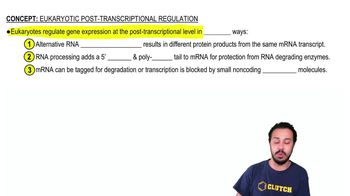Here are the essential concepts you must grasp in order to answer the question correctly.
Iron Regulation in Bacteria
Bacteria like E. coli have evolved mechanisms to regulate gene expression in response to iron availability. When iron is scarce, the bacterium can downregulate the synthesis of proteins that require iron as a cofactor, ensuring that resources are conserved and that essential functions are maintained under nutrient-limited conditions.
Recommended video:
Introduction to Regulation of Gene Expression
Transcriptional Regulation
Transcriptional regulation involves controlling the transcription of specific genes based on environmental signals. In the case of E. coli, the presence or absence of iron can influence the binding of regulatory proteins to DNA, leading to the activation or repression of genes involved in iron-dependent processes, such as the synthesis of superoxide dismutase and succinate dehydrogenase.
Recommended video:
Eukaryotic Post-Transcriptional Regulation
Iron-Responsive Elements (IREs)
Iron-Responsive Elements are specific RNA sequences found in the untranslated regions of mRNAs that encode iron-dependent proteins. When iron levels are low, regulatory proteins can bind to these IREs, preventing translation of the mRNA and thus inhibiting the production of proteins that require iron, effectively allowing the cell to adapt to iron scarcity.
Recommended video:






